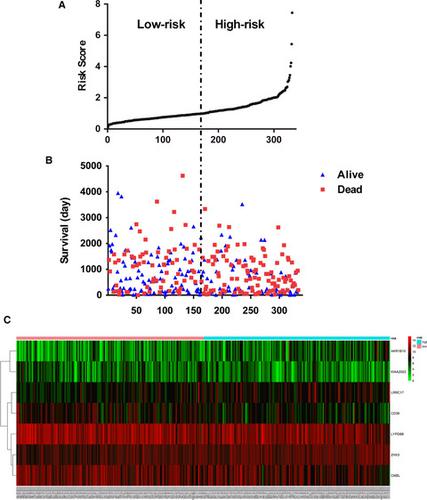当前位置:
X-MOL 学术
›
Cancer Med.
›
论文详情
Our official English website, www.x-mol.net, welcomes your
feedback! (Note: you will need to create a separate account there.)
Bioinformatic profiling identifies a platinum-resistant-related risk signature for ovarian cancer.
Cancer Medicine ( IF 2.9 ) Pub Date : 2019-12-19 , DOI: 10.1002/cam4.2692 Ce Wu 1, 2 , Linxiu He 1, 2 , Qian Wei 1, 2 , Qian Li 3 , Longyang Jiang 1, 2 , Lan Zhao 1, 2 , Chunyan Wang 3 , Jianping Li 1, 2, 4 , Minjie Wei 1, 2
Cancer Medicine ( IF 2.9 ) Pub Date : 2019-12-19 , DOI: 10.1002/cam4.2692 Ce Wu 1, 2 , Linxiu He 1, 2 , Qian Wei 1, 2 , Qian Li 3 , Longyang Jiang 1, 2 , Lan Zhao 1, 2 , Chunyan Wang 3 , Jianping Li 1, 2, 4 , Minjie Wei 1, 2
Affiliation

|
Most high-grade serous ovarian cancer (HGSOC) patients develop resistance to platinum-based chemotherapy and recur. Many biomarkers related to the survival and prognosis of drug-resistant patients have been delved by mining databases; however, the prediction effect of single-gene biomarker is not specific and sensitive enough. The present study aimed to develop a novel prognostic gene signature of platinum-based resistance for patients with HGSOC. The gene expression profiles were obtained from Gene Expression Omnibus and The Cancer Genome Atlas database. A total of 269 differentially expressed genes (DEGs) associated with platinum resistance were identified (P < .05, fold change >1.5). Functional analysis revealed that these DEGs were mainly involved in apoptosis process, PI3K-Akt pathway. Furthermore, we established a set of seven-gene signature that was significantly associated with overall survival (OS) in the test series. Compared with the low-risk score group, patients with a high-risk score suffered poorer OS (P < .001). The area under the curve (AUC) was found to be 0.710, which means the risk score had a certain accuracy on predicting OS in HGSOC (AUC > 0.7). Surprisingly, the risk score was identified as an independent prognostic indicator for HGSOC (P < .001). Subgroup analyses suggested that the risk score had a greater prognostic value for patients with grade 3-4, stage III-IV, venous invasion and objective response. In conclusion, we developed a seven-gene signature relating to platinum resistance, which can predict survival for HGSOC and provide novel insights into understanding of platinum resistance mechanisms and identification of HGSOC patients with poor prognosis.
中文翻译:

生物信息分析确定了卵巢癌的铂耐药相关风险特征。
大多数高级别浆液性卵巢癌 (HGSOC) 患者对铂类化疗产生耐药性并复发。许多与耐药患者生存和预后相关的生物标志物已通过挖掘数据库得到深入研究;但单基因生物标志物的预测效果不够特异和灵敏。本研究旨在为 HGSOC 患者开发一种新的铂类耐药预后基因特征。基因表达谱来自基因表达综合数据库和癌症基因组图谱数据库。总共鉴定了 269 个与铂耐药相关的差异表达基因 (DEG)(P < .05,倍数变化 >1.5)。功能分析显示这些DEG主要参与细胞凋亡过程、PI3K-Akt通路。此外,我们在测试系列中建立了一组与总生存期 (OS) 显着相关的七基因特征。与低风险评分组相比,高风险评分患者的 OS 较差 (P < .001)。曲线下面积(AUC)为0.710,这意味着风险评分对预测HGSOC的OS有一定的准确性(AUC> 0.7)。令人惊讶的是,风险评分被确定为 HGSOC 的独立预后指标 (P < .001)。亚组分析提示,风险评分对于3-4级、III-IV期、静脉侵犯和客观缓解的患者具有更大的预后价值。总之,我们开发了与铂类耐药相关的七基因特征,它可以预测 HGSOC 的生存率,并为理解铂类耐药机制和识别预后不良的 HGSOC 患者提供新的见解。
更新日期:2019-12-19
中文翻译:

生物信息分析确定了卵巢癌的铂耐药相关风险特征。
大多数高级别浆液性卵巢癌 (HGSOC) 患者对铂类化疗产生耐药性并复发。许多与耐药患者生存和预后相关的生物标志物已通过挖掘数据库得到深入研究;但单基因生物标志物的预测效果不够特异和灵敏。本研究旨在为 HGSOC 患者开发一种新的铂类耐药预后基因特征。基因表达谱来自基因表达综合数据库和癌症基因组图谱数据库。总共鉴定了 269 个与铂耐药相关的差异表达基因 (DEG)(P < .05,倍数变化 >1.5)。功能分析显示这些DEG主要参与细胞凋亡过程、PI3K-Akt通路。此外,我们在测试系列中建立了一组与总生存期 (OS) 显着相关的七基因特征。与低风险评分组相比,高风险评分患者的 OS 较差 (P < .001)。曲线下面积(AUC)为0.710,这意味着风险评分对预测HGSOC的OS有一定的准确性(AUC> 0.7)。令人惊讶的是,风险评分被确定为 HGSOC 的独立预后指标 (P < .001)。亚组分析提示,风险评分对于3-4级、III-IV期、静脉侵犯和客观缓解的患者具有更大的预后价值。总之,我们开发了与铂类耐药相关的七基因特征,它可以预测 HGSOC 的生存率,并为理解铂类耐药机制和识别预后不良的 HGSOC 患者提供新的见解。











































 京公网安备 11010802027423号
京公网安备 11010802027423号